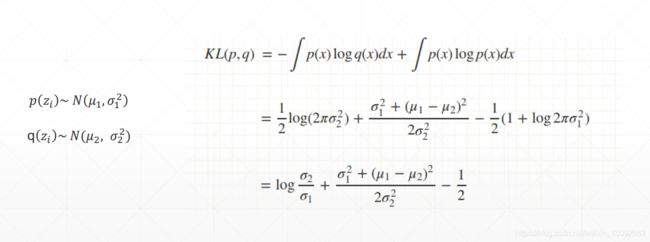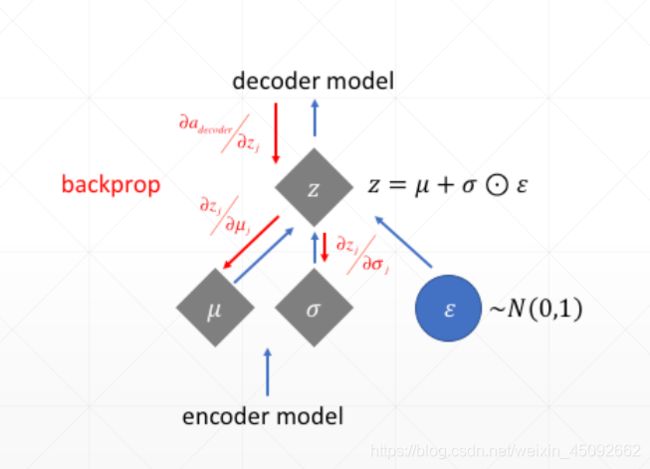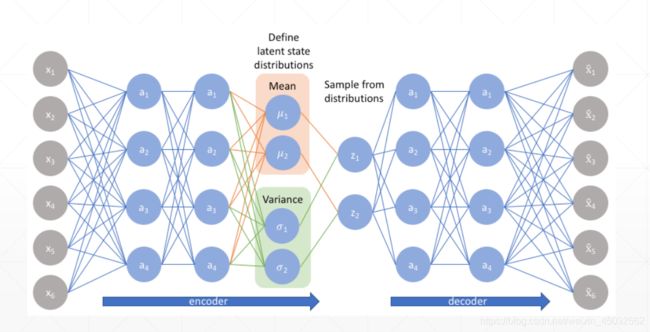pytorch利用变分自编码器进行MNIST实战
自编码器是一种无监督学习
它的作用:
1、降维
2、预处理
3、可视化
4、利用无监督的数据
5、压缩(有损)、降噪、超分辨率
原理
一句话概括,自己训练自己。
怎么训练
PCA和Auto-Encoders的区别
PCA的线性变换对特征维度的类型有限制,AE可以是非线性变换。
降噪AE
KL散度
KL计算公式:

通过这样的技巧,在反向传播中就可以顺利通过了。


可以理解为这样:

main.py代码为:
import torch
from torch.utils.data import DataLoader
from torch import nn, optim
from torchvision import transforms, datasets
# from ae import AE
from vae import VAE
import visdom
def main():
mnist_train = datasets.MNIST('mnist', True, transform=transforms.Compose([
transforms.ToTensor()
]), download=True)
mnist_train = DataLoader(mnist_train, batch_size=256, shuffle=True)
mnist_test = datasets.MNIST('mnist', False, transform=transforms.Compose([
transforms.ToTensor()
]), download=True)
mnist_test = DataLoader(mnist_test, batch_size=256, shuffle=True)
x, _ = iter(mnist_train).next()
print("x:", x.shape)
device = torch.device('cuda')
# model = AE().cuda()
model = VAE().cuda()
criteon = nn.MSELoss()
optimizer = optim.Adam(model.parameters(), lr=1e-3)
print(model)
viz = visdom.Visdom()
for epoch in range(1000):
for batchidx, (x, _) in enumerate(mnist_train):
# [b, 1, 28, 28]
x = x.cuda()
x_hat, kld = model(x)
loss = criteon(x_hat, x)
if kld is not None:
elbo = -loss - 1.0 * kld
loss = - elbo
# backprop
optimizer.zero_grad() # 梯度清零
loss.backward()
optimizer.step() # 更新梯度
print(epoch, 'loss:', loss.item(), 'kld', kld.item())
x, _ = iter(mnist_test).next()
x = x.cuda()
with torch.no_grad():
x_hat, kld = model(x)
viz.images(x, nrow=8, win='x', opts=dict(title='x'))
viz.images(x_hat, nrow=8, win='x_hat', opts=dict(title='x_hat'))
if __name__ == '__main__':
main()
vae.py代码为:
import torch
from torch import nn
class VAE(nn.Module):
"""
"""
def __init__(self):
"""
"""
super(VAE, self).__init__()
# [b, 784] => [b, 20]
# u均值: [b, 10]
# sigma标准差: [b, 10]
self.encoder = nn.Sequential(
nn.Linear(784, 256),
nn.ReLU(),
nn.Linear(256, 64),
nn.ReLU(),
nn.Linear(64, 20),
nn.ReLU()
)
# [b, 10] => [b, 784]
self.decoder = nn.Sequential(
nn.Linear(10, 64),
nn.ReLU(),
nn.Linear(64, 256),
nn.ReLU(),
nn.Linear(256, 784),
nn.Sigmoid() # 压缩像素为0到1
)
def forward(self, x):
"""
:param x: [b, 1, 28, 28]
:return:
"""
batchsz = x.shape[0]
# flatten
x = x.view(batchsz, 784)
# encoder
# [b, 784] => [b, 20],包括均值和方差
h_ = self.encoder(x)
# [b, 20] => [b, 10] 和 [b, 10]
mu, sigma = h_.chunk(2, dim=1)
# 重新参数化技巧,epison ~ N(0,1),变为可导的操作
h = mu + sigma * torch.randn_like(sigma)
# torch.pow():幂次运算
kld = 0.5 * torch.sum(
torch.pow(mu, 2) +
torch.pow(sigma, 2) -
torch.log(1e-8 + torch.pow(sigma, 2)) - 1
) / (batchsz * 28 * 28)
# decoder
# [b, 10] => [b, 784]
x_hat = self.decoder(h)
# reshape, [b, 784] => [b, 1, 28, 28]
x_hat = x_hat.view(batchsz, 1, 28, 28)
return x_hat, kld
def main():
x = torch.randn(256, 1, 28, 28)
model = VAE()
out1, out2 = model(x)
print('x_hat:', out1.shape)
print('kld:', out2)
# 查看模型结构
print(model)
if __name__ == '__main__':
main()
ae.py代码为:
import torch
from torch import nn
class AE(nn.Module):
"""
"""
def __init__(self):
"""
"""
super(AE, self).__init__()
# [b, 784] => [b, 20]
self.encoder = nn.Sequential(
nn.Linear(784, 256),
nn.ReLU(),
nn.Linear(256, 64),
nn.ReLU(),
nn.Linear(64, 20),
nn.ReLU()
)
# [b, 20] => [b, 784]
self.decoder = nn.Sequential(
nn.Linear(20, 64),
nn.ReLU(),
nn.Linear(64, 256),
nn.ReLU(),
nn.Linear(256, 784),
nn.Sigmoid() # 压缩像素为0到1
)
def forward(self, x):
"""
:param x: [b, 1, 28, 28]
:return:
"""
batchsz = x.shape[0]
# flatten,打平数据,[b, 1, 28, 28] => [b, 784]
x = x.view(batchsz, 784)
# encoder
x = self.encoder(x)
# decoder
x = self.decoder(x)
# reshape, [b, 784] => [b, 1, 28, 28]
x = x.view(batchsz, 1, 28, 28)
return x
def main():
x = torch.randn(256, 1, 28, 28)
model = AE()
out = model(x)
print('x:', out.shape)
# 查看模型结构
print(model)
if __name__ == '__main__':
main()
运行时打开visdom可视化界面,代码为:
python -m visdom.server
在网页中输入:
localhost:8097

虽然有点模糊,是因为训练次数比较少,次数多后,后面会原来越来越清晰。
有用请点个赞!!
本站所有文章均为原创,欢迎转载,请注明文章出处:https://blog.csdn.net/weixin_45092662。百度和各类采集站皆不可信,搜索请谨慎鉴别。技术类文章一般都有时效性,本人习惯不定期对自己的博文进行修正和更新,因此请访问出处以查看本文的最新版本。

